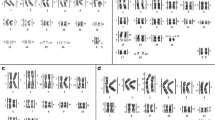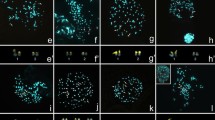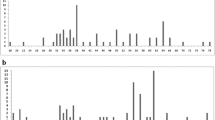Abstract
Comparative cytogenetic studies on Xenarthra, one of the most basal mammalian clades in the Placentalia, are virtually absent, being restricted largely to descriptions of conventional karyotypes and diploid numbers. We present a molecular cytogenetic comparison of chromosomes from the two-toed (Choloepus didactylus, 2n = 65) and three-toed sloth species (Bradypus tridactylus, 2n = 52), an anteater (Tamandua tetradactyla, 2n = 54) which, together with some data on the six-banded armadillo (Euphractus sexcinctus, 2n = 58), collectively represent all the major xenarthran lineages. Our results, based on interspecific chromosome painting using flow-sorted two-toed sloth chromosomes as painting probes, show the sloth species to be karyotypically closely related but markedly different from the anteater. We also test the synteny disruptions and segmental associations identified within Pilosa (anteaters and sloths) against the chromosomes of the six-banded armadillo as outgroup taxon. We could thus polarize the 35 non-ambiguously identified chromosomal changes characterizing the evolution of the anteater and sloth genomes and map these to a published sequence-based phylogeny for the group. These data suggest a low rate of genomic repatterning when placed in the context of divergence estimates based on molecular and fossil data. Finally, our results provide a glimpse of a likely ancestral karyotype for the extant Xenarthra, a pivotal group for understanding eutherian genome evolution.
Similar content being viewed by others
References
Amrine-Madsen H, Koepfli K-P, Wayne RK, Springer MS (2003) A new phylogenetic marker, apolipoprotein B, provides compelling evidence for eutherian relationships. Mol Phylogenet Evol 28: 225–240.
Chowdhary BP, Raudsepp T, Frönicke L, Scherthan H (1998) Emerging patterns of comparative genome organization in some mammalian species as revealed by ZOO-FISH. Genome Res 8: 577–589.
Corin-Frédéric J (1969) Les formules gonosomiques dites aberrantes chez les mammifères euthériens. Chromosoma 27: 268–287.
Delsuc F, Catzeflis FM, Stanhope MJ, Douzery E (2001) The evolution of armadillos, anteaters and sloths depicted by nuclear and mitochondrial phylogenies: implications for the status of the enigmatic fossil Eurotamandua. Proc R Soc Lond 268: 1605–1615.
Delsuc F, Scaly M, Stanhope MJ et al. (2002) Molecular phylogeny of living xenarthrans and the impact of characters and taxon sampling on the placental tree rooting. Mol Biol Evol 19: 1656–1671.
Delsuc F, Stanhope MJ, Douzery E (2003) Molecular systematics of armadillos (Xenarthra, Dasypodidae): contribution of maximum likelihood and Bayesian analyses of mitochondrial and nuclear genes. Mol Phylogenet Evol 28: 261–275.
Delsuc F, Vizcaino SF, Douzery E (2004) Influence of Tertiary paleoenvironmental changes on the diversification of South American mammals: a relaxed molecular clock study within xenarthrans. BMC Evol Biol 4: 11.
Engelman GF (1985) The phylogeny of Xenarthra. In: Montgomery GG, ed. The evolution and Ecology of Armadillos, Sloths and Vermilinguas. Washington and London: Smithsonian University Press, pp 51–64.
Höss M, Dilling A, Currant A, Pääbo S (1996) Molecular phylogeny of the extinct ground sloth Mylodon darwinii. Proc Natl Acad Sci USA 93: 181–185.
Hsu TC (1965) Chromosomes of two species of anteaters. Mamm Chromosome Newslett 15: 108–109.
Hsu TC, Benirschke K (1969) Tamandua tetradactyla. Atlas Mamm Chromosomes 3: 108.
Jorge, W. Estudo cromossomico de algumas especies da Ordem Edentata. PhD Thesis, Instituto Basico de Biologia Medica e Agricola, Sao Paulo, Brazil, 1981.
Jorge W, Meritt DA, Benirschke K (1978) Chromosome studies in Edentata. Cytobios 18: 157–172.
Jorge W, Orsi-Souza AT, Best R (1985) The somatic chromosomes of Xenarthra. In: Montgomery GG, ed. The Evolution and Ecology of Armadillos, Sloths and Vermilinguas. Washington and London: Smithsonian Institution Press.
Kovacs A, Révay T, Tardy PE, Mezosi L (2001) 2n = 65 karyotype in a two-toed sloth (Choloepus didactylus, L.). Ann Génét 44: 43.
Madsen O, Scally M, Douady CJ, Kao DJ et al. (2001) Parallel adaptative radiations in two major clades of placental mammals. Nature 409: 610–614.
Misceo D, Cardone MF, Carbone L et al. (2004) Evolutionary history of chromosome 20. Mol Biol Evol 22: 360–366.
Müller S, Hollatz M, Wienberg J (2003) Chromosomal phylogeny and evolution of gibbons (Hylobatidae). Hum Genet 113: 493–501.
Murphy WJ, Eizirik E, O'Brien SJ et al. (2001a) Resolution of the early placental mammal radiation using Bayesian phylogenetics. Science 295: 2348–2351.
Murphy WJ, Eizirik E, Johnson WE, Ping Zhang YP, Ryder OA, O'Brien SJ (2001b) Molecular phylogenetics and the origin of placental mammals. Nature 409: 614–618.
Murphy WJ, Stanyon R, O'Brien SJ (2001c) Evolution of mammalian genome organization inferred from comparative gene mapping. Genome Biol 2: 1–8.
Murphy WJ, Frönicke L, O'Brien SJ, Stanyon R (2003) The origin of human chromosome 1 and its homologs in placental mammals. Genome Res 13: 1880–1888.
Murphy WJ, Pevzner PA, O'Brien SJ (2004) Mammalian phylogenomics comes of age. Trends Genet 20: 631–639.
Nash WG, Menninger JC, Wienberg J, Padilla-Nash HM, O'Brien SJ (2001) The pattern of phylogenomic evolution of the Canidae. Cytogenet Cell Genet 95: 210–224.
Nowak RM (1999) Walkers Mammals of the World, 6th edn. Baltimore and London: The Johns Hopkins University Press.
O'Neill RJ, Eldridge MDB, Metcalfe CJ (2004) Centromere dynamics and chromosome evolution in Marsupials. J Heredity 95: 375–381.
Pereira HRJ, Jorge W, Teixeira da Costa MEL (2004) Chromosome study of anteaters (Myrmecophagidae, Xenarthra): a preliminary report. Genet Mol Biol 27: 391–394.
Richard F, Lombard M, Dutrillaux B (2000) Phylogenetic origin of human chromosomes 7, 16 and 19 and their homologs in placental mammals. Genome Res 10: 644–651.
Robinson TJ, Seiffert E (2004) Afrotherian origins and interrelationships: new views and future prospects. Curr Top Dev Biol 63: 37–60.
Rokas A, Holland WA (2000) Rare genomic changes as a tool for phylogenetics. Trends Ecol Evol 15: 454–459.
Seabright M (1971) A rapid banding technique for human chromosomes. Lancet 2: 971–972.
Springer MS, Murphy WJ, Eizirik E, O'Brien SJ (2003) Placental mammal diversification and the Cretaceous–Tertiary boundary. Proc Natl Acad Sci USA 100: 1056–1061.
Springer MS, Stanhope MJ, Madsen O, de Jong WW (2004) Molecules consolidate the placental mammal tree. Trends Ecol Evol 19: 430–438.
Sumner AA (1972) A simple technique for demonstrating centromeric heterochromatin. Exp Cell Res 75: 304–306.
Telenius H, Pelmear AH, Tunnacliffe A et al. (1992) Cytogenetic analysis by chromosome painting using DOP–PCR amplified flow-sorted chromosomes. Gene Chromosome Cancer 4: 257–263.
Trifonov V, Yang F, Ferguson-Smith MA, Robinson TJ (2003) Cross-species chromosome painting in the Perissodactyla: delimitation of homologous regions in Burchell's zebra (Equus burchellii) and the white (Ceratotherium simum) and black rhinoceros (Diceros bicornis). Cytogenet Genome Res 103: 104–110.
van Dijk MAM, Paradis E, Catzeflis F, de Jong WW (1999) The virtue of gaps: xenarthran (Edentates) monophyly supported by a unique deletion in alpha A-crystallin. Syst Biol 48: 94–106.
Ventura M, Weigl S, Carbone L et al. (2004) Recurrent sites for centromere seeding. Genome Res 14: 1696–1703.
Volobouev V, Aniskin VM, Lecompte E, Ducroz JF (2002) Patterns of karyotype evolution in complexes of sibling species within three genera of African murid rodents inferred from the comparison of cytogenetic and molecular data. Cytogenet Genome Res 96: 261–275.
Wang W, Lan H (2000) Rapid and parallel chromosomal number reductions in Muntjac deer inferred from mitochrondrial DNA phylogeny. Mol Biol Evol 17: 1326–1333.
Waters P, Dobigny G, Pardini A, Robinson TJ (2004) LINE-1 distribution in the two most basal eutherian clades, Afrotheria and Xenarthra: implications for understanding the biology of L1 in the human and mouse genomes. Chromosoma 113: 137–144.
Wienberg J, Stanyon R (1997) Comparative painting of mammalian chromosomes. Curr Opin Genet Dev 7: 784–791.
Yang F, O'Brien PCM, Wienberg J, Neitzel H, Lin CC, Ferguson-Smith MA (1997) Chromosomal evolution of the Chinese muntjac (Muntiacus reevesi). Chromosoma 106: 37–43.
Yang F, Fu B, O'Brien PCM, Robinson TJ, Ryder OA, Ferguson-Smith MA (2003) Karyotypic relationships of horses and zebras: results of cross-species chromosome painting. Cytogenet Genome Res 102: 235–243.
Author information
Authors and Affiliations
Corresponding author
Rights and permissions
About this article
Cite this article
Dobigny, G., Yang, F., O'Brien, P.C.M. et al. Low rate of genomic repatterning in Xenarthra inferred from chromosome painting data. Chromosome Res 13, 651–663 (2005). https://doi.org/10.1007/s10577-005-1002-9
Received:
Accepted:
Published:
Issue Date:
DOI: https://doi.org/10.1007/s10577-005-1002-9




